 La Plata
La PlataDental
 La Plata
La Plata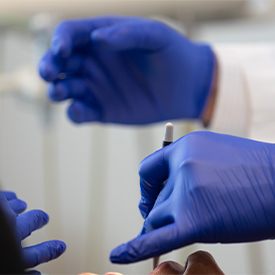
The side effects of tooth loss are significant and can range from difficulty eating and speaking to experiencing even more missing teeth later on. When you have lost a tooth, you are also missing the supportive root structure -- or the part which brings important nutrients and blood flow to the jawbone. Over time, the tissue will reabsorb due to disuse. This causes the remaining natural teeth to lose their sturdy foundation, which will eventually result in them falling out as well. That’s why, even when only one tooth has been lost, replacing it with a dental implant (for eligible candidates) is of the utmost importance. To learn how the process works and see if dental implants are right for you, give La Plata Dental a call today!
A dental implant is a standalone, comprehensive tooth replacement option which does not alter the natural teeth surrounding the gap left by the missing tooth. A tiny titanium post (the dental implant) can take the place of the tooth’s root. After the post has fused together with the jaw, it will be exposed once more and a connecting abutment can be placed on top. A natural-looking crown made from biocompatible materials will be affixed to the abutment to restore the dental implant and renew your ability to eat, speak, and smile with confidence once more. Of course, you can also use dental implants to replace any number of teeth, making the process incredibly versatile.
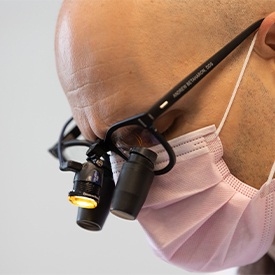
It should come as no surprise that dental implant treatment cannot be completed in a single appointment. You’ll need to visit our office multiple times over the course of several months. However, the longevity that dental implants provide makes them worth waiting for! To make things more convenient, Dr. Hochman and Dr. Betaharon have the advanced training necessary to be able to perform every step of the dental implant process in one location, unlike many general dentists. If you’re interested in how dental implants work in La Plata, read on for a basic outline of the process:

First things first, we’ll need to make sure that dental implants are right for you. Jawbone density, oral health, and whole-body health can all influence the outcome of your procedure. If we decide to move forward with dental implants, we can schedule the placement surgery. We can also plan out any preliminary treatments you may need to prepare your mouth beforehand, such as gum disease therapy that could lead to implant complications.
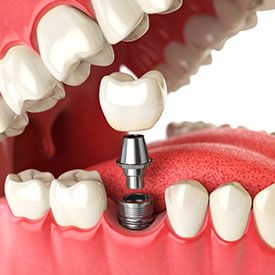
The dental implant surgery involves making a small incision in your gum tissue and preparing a space in the jaw for the dental implant post. Then, your implant dentist in La Plata will insert the titanium post into that space. Once in place, a protective cap is attached to the implant. This allows the gums to heal and the implant post to fuse with the surrounding bone, but keeps the gums shaped to fit around a tooth naturally.
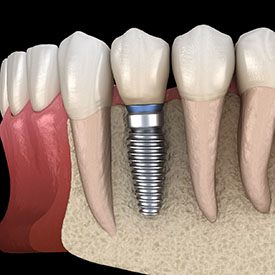
Following the dental implant placement procedure, patients will need to wait three to six months to allow the implant post to fuse with the supportive alveolar bone and gum tissue. This process is known as osseointegration, and it is a big part of what makes dental implant tooth replacement unique compared with other solutions.
When the osseointegration process is complete, patients return to our office to undergo another minor surgery. We’ll expose the implant posts in order to attach metal fixtures called abutments. This device will allow us to attach your custom-made restorations to your dental implants in La Plata.
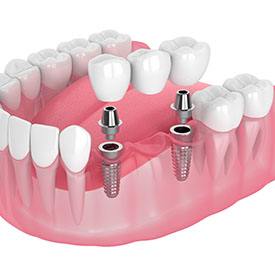
After your abutment surgery, we’ll capture impressions of your mouth. These will serve as the blueprints for the skilled technicians at a partnered dental lab to craft your replacement teeth. A few weeks later, when we’ve received your restoration, you’ll come back to our office to have it placed atop your abutment. Once we’ve affixed your crown, bridge, or denture into place, you’re free to enjoy your brand-new smile!
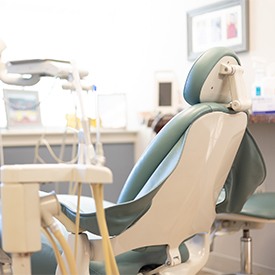
Because tooth replacement through dental implants is complex, we completely understand if you’re hesitant about moving forward with an implant treatment plan. Dental implants offer a wide range of benefits that you can’t achieve with dentures or dental implants. Here are some of the most prominent ones.

Dental implants look and feel like real teeth do. You shouldn’t even detect much of a difference in your everyday life. Here are some of the daily benefits that you can enjoy.

In addition to daily benefits, your health will be positively affected by your dental implants. Here are some health benefits you can experience.

When you choose dental implants, you are making a long-term investment in the future of your smile. Here are some of the benefits you can enjoy for many years down the road.
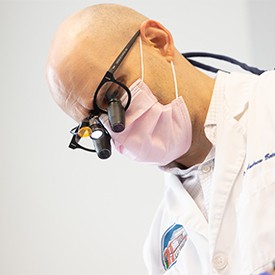
Dental implants allow us to replace the lost root structure of teeth for a more natural looking and feeling restoration, no matter how severe your tooth loss might be. If you’d like to find out more about your tooth replacement options at La Plata Dental, please consider reviewing your options below or give us a call directly!
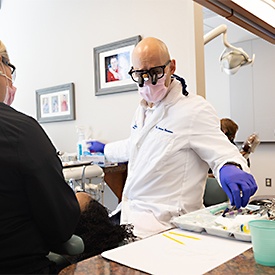
Many adults who have lost teeth are indeed eligible for replacement with an implant crown. You should be in good oral and overall health in order to successfully undergo an implant procedure. If the tooth has been missing for a while or if you have had gum disease, you may need to undergo a bone graft or sinus lift first. Smoking or tobacco use can increase the risk of implant failure, so patients are advised to quit the habit or to dramatically reduce tobacco intake before getting dental implants.
A single crown can be crafted to attach to one dental implant post. In some cases, two consecutive teeth can be replaced by fusing two dental crowns together and anchoring them to the same implant. For three or more consecutive missing teeth, a row of replacement teeth will be fused together to create a bridge that is then attached to two implant posts, one at each end.
Patients with more advanced tooth loss will likely want to consider an implant denture. Whether you’re being fitted for your very first dental prosthetic or you want to improve the stability of an existing denture, an implant denture may be a good solution. Like traditional removable partial and full dentures, implant prosthetics use a gum-colored material to create a base for numerous replacement teeth.
If you still have healthy teeth, we’ll shape a partial to fit between these preserving your remaining tooth structure. If you are completely edentulous (without teeth), the base is shaped to fit securely against the gum line. For most patients, a partial or full denture can be retained or supported with about two to six strategically positioned dental implant posts. Once in place, your implant dental prosthetic is secured to your jaw, significantly increasing the stability of dentures and restoring as much as 70% of chewing function. This is compared to traditional dentures that only allow for about 25% to 30% restoration.

Every dental implant tooth replacement plan is different. For this reason, we’ll need to see you in our dental office for an implant consultation in order to provide an accurate estimate of the out of pocket costs of your treatment plan. Our knowledgeable team members will help you plan and budget for your dental implant tooth replacement, and we’ll be happy to answer all of your questions about dental implants and the costs associated with your restoration plan. We’re happy to walk through some of the factors that influence the cost of your dental implant restoration plan below. Give La Plata Dental a call to schedule your tooth replacement consultation and get started putting a smile back on your face today.

Before we get started with an advanced dental treatment like tooth replacement with dental implants, we may need to provide a number of preparatory treatments to ensure your optimal chances for successful implant placement. These preparatory procedures may include tooth extractions and bone or soft tissue grafts.
Additionally, many people choose to utilize dental sedation to ensure comfort during the more invasive aspects of your tooth replacement plan, which can further add to the out of pocket expense of implant restoration.
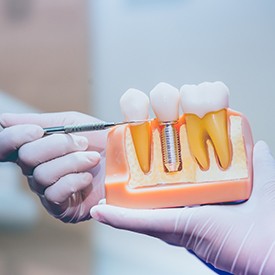
The largest factor in the price of your restoration plan is the cost of dental implant posts and their surgical placement. Dental implants can be crafted from a number of different materials, including titanium and metal-free zirconia. Your dental implants will vary in price depending on the materials used, manufacturers, the size of your implant post, and the position of your missing tooth.
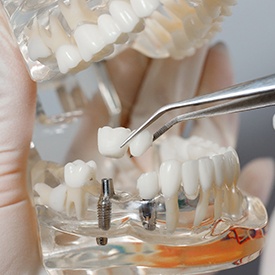
Once your dental implant posts are fused with the supportive bone and gum tissue, you’ll come in so we can place an abutment over the top of each implant. The abutments are used to attach your crown, bridge, or denture to the underlying implants.

In addition to these major aspects that influence treatment pricing, there are also a few other variables to keep in mind. The first is dental insurance. While insurance plans don’t usually cover the price of dental implant posts or their placement, your benefit provider will usually offer coverage for other aspects of your implant tooth replacement plan, including replacement teeth and preparatory procedures.
For those without dental insurance or who want to spread out the cost of their restoration plan, we’re happy to work with third-party financiers to offer low or no interest financing plans.
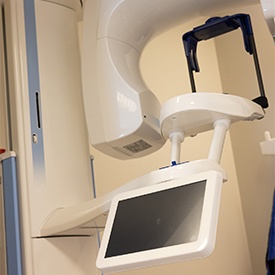
When placing dental implants, it’s incredibly important to make the procedure as predictable as possible. The more that we understand about your current bone structure, gum tissue, and other essential areas of the mouth, the better the outcome of your treatment will be. For example, the CBCT scanner makes sure we know exactly where your nerves are, so we don’t accidentally hit them while placing the implant. The same logic applies for blood vessels, which we want to avoid at all costs while placing. Furthermore, a 3D scanner makes it much easier to know how much bone tissue we have to work with when it comes to placing the implants.

One of the many reasons that dental implants are so popular is because of their lifespan; they can last for 30 years or more with the proper care. If you’re not exactly sure what that entails, then this next section is for you! Below, you’ll find helpful information about how to protect, clean, and maintain your new and improved smile.

While dental implants cannot decay, you still need to brush, floss, and rinse with mouthwash consistently. Otherwise, an infection can develop in your gums, and any remaining natural teeth you have can decay. So, if you want to maintain a beautiful, complete smile and healthy bite, do your best to incorporate healthy dental care habits into your daily routine.

Patients sometimes forget just how big of an impact their diet has on their oral health. The truth is that eating lots of crunchy, sugary, and starchy foods dramatically increases your risk of dental trouble. Conversely, eating seasonal fruits, lean proteins, and healthy fats benefits your oral and overall health. So, do your best to eat healthy, well-balanced meals the majority of the time.

Breaking bad habits is vital. So, if you haven’t already, put a plan in place to stop smoking, biting your nails, chewing on ice cubes, and using your teeth as tools to open things. We understand that this is often easier said than done, so don’t hesitate to let us know if you need any recommendations! We’d be happy to share what has worked for our patients in the past.

Another way to prolong the lifespan of your dental implants is by wearing a nightguard while you sleep, particularly if you grind/clench your teeth at night. You should also wear a mouthguard if you play a sport (even a non-contact one). Measures like these may seem insignificant, but they can dramatically reduce your risk of a serious chip, crack, or fracture.

Again, even though dental implants are decay-resistant, you still need to take good care of your smile. That starts with daily habits, like brushing twice a day, and extends to coming to our office twice a year for a checkup. That way, we can routinely examine the condition of your dental implant as well as conduct an oral cancer screen and look for early warning signs of gum disease.

Our goal is to make finding the answers you’re looking for as easy as possible. That’s why we encourage you to talk to our helpful dental team in La Plata – we’re genuinely here to help! Of course, if you’re not quite ready to call yet, that’s okay too. In that case, you can read on to learn the answers to frequently asked questions about dental implants.
Simply put, candidacy for dental implants isn’t determined by age. Instead, important factors like your jawbone density, your commitment to a solid oral hygiene regimen, and if you smoke need to be considered. So, don’t let your age stop you from scheduling an appointment!
Fortunately, the first step of the process is numbing your mouth with a local anesthetic. This will ensure that you don’t feel any pain during your treatment. At most, you will feel some slight pressure from our team working. Of course, during the healing process, it’s normal to experience some soreness. The good news is that we will provide you with a list of aftercare instructions that will help minimize this sensation, including taking OTC pain medication as directed and using a cold compress to address uncomfortable swelling.
Although rare, it is possible for dental implants to “fail.” This could be the result of everything from tobacco use to certain health concerns, like diabetes. However, it’s most often the result of peri-implantitis or failed osseointegration. The first is a form of gum disease that develops due to poor oral hygiene. The second is when the jawbone and dental implant don’t fuse together properly, causing it to become loose or fall out altogether.
While smoking doesn’t automatically mean that you can’t get dental implants, it does pose numerous risks. For example, tobacco products are known to slow down the healing process, which can negatively impact your results. Furthermore, smoking can dislodge the blood clot that forms over the implant site, which can be quite painful. That’s why patients who smoke are encouraged to kick the habit altogether.
Dental implants aren’t made of enamel, so they don’t decay. Of course, that doesn’t mean you don’t have to brush or floss your teeth anymore. Not only are your remaining teeth still vulnerable to decay, but adopting unhealthy dental habits can also result in gum disease. Since both of these can negatively impact the look and function of your smile as well as your dental implants, it’s of the utmost importance that you commit to a solid oral hygiene routine at home and visit us biannually for a checkup and cleaning.
Remember, the longevity of your dental implants depends largely on one thing: how well you care for them. With that said, they do have the potential to last for two decades or more! At your appointment, we will give you thorough instructions on how to keep yours in pristine condition so they last as long as possible.